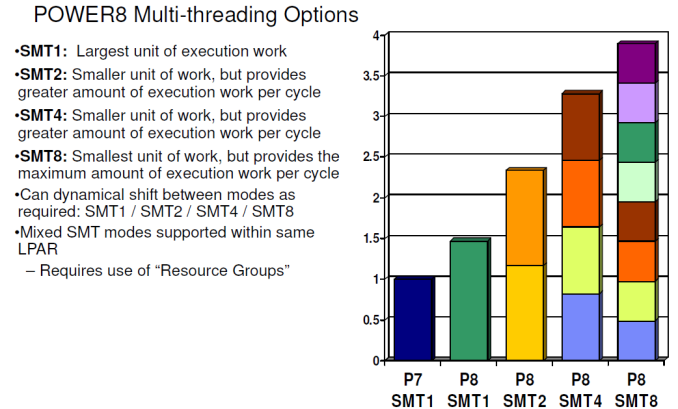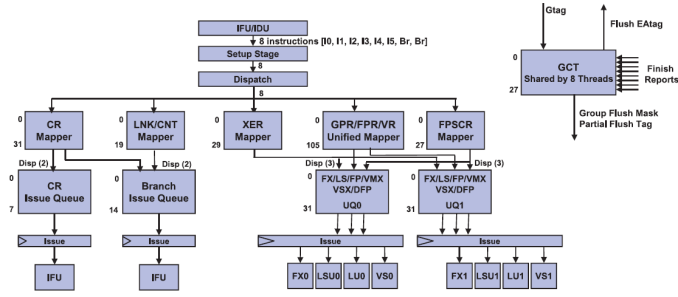Assessing IBM's POWER8, Part 1: A Low Level Look at Little Endian
by Johan De Gelas on July 21, 2016 8:45 AM ESTMulti Threading Prowess
The gains of 2-way SMT (Hyperthreading) on Intel processors are still relatively small (10-20%) in many applications. The reason is that threads have to share most of the critical resources such as L1-cache, the instruction TLB, µop cache, and instruction queue. That IBM uses 8-way SMT and still claims to get significant performance gains piqued our interest. Is this just benchmarketing at best or did they actually find a way to make 8-way SMT work?
It is interesting to note that with 2-way SMT, a single thread is still running at about 80% of its performance without SMT. IBM claims no less than a 60% performance increase due to 2-way SMT, far beyond what Intel has ever claimed (30%). This can not be simply explained by the higher amount of issue slots or decoding capabilities.
The real reason is a series of trade-offs and extra resource investments that IBM made. For example, the fetch buffer contains 64 instructions in ST mode, but twice as many entries are available in 2-way SMT mode, ensuring each thread still has a 64 instruction buffer. In SMT4 mode, the size of the fetch buffer for each thread is divided in 2 (32 instructions), and only in SMT8 mode things get a bit cramped as the buffer is divided by 4.
The design philosophy of making sure that 2 threads do not hinder each other can be found further down the pipeline. The Unified Issue Queue (UniQueue) consists of two symmetric halves (UQ0 and UQ1), each with 32 entries for instructions to be issued.
Each of these UQs can issue instructions to their own reserved Load/Store, Integer (FX), Load, and Vector units. A single thread can use both queues, but this setup is less flexible (and thus less performant) than a single issue queue. However, once you run 2 threads on top of a core (SMT-2), the back-end acts like it consists of two full-blown 5-way superscalar cores, each with their own set of physical registers. This means that one thread cannot strangle the other by using or blocking some of the resources. That is the reason why IBM can claim that two threads will perform so much better than one.
It is somewhat similar to the "shared front-end, dual-core back-end" that we have seen in Bulldozer, but with (much) more finesse. For example, the data cache is not divided. The large and fast 64 KB D-cache is available for all threads and has 4 read ports. So two threads will be able to perform two loads at the same time. Another example is that a single thread is not limited to one half, but can actually use both, something that was not possible with Bulldozer.
Dividing those ample resources in two again (SMT-4) should not pose a problem. All resources are there to run most server applications fast and one of the two threads will regularly pause when a cache miss or other stalls occur. The SMT-8 mode can sometimes be a step too far for some applications, as 4 threads are now dividing up the resources of each issue queue. There are more signs that SMT-8 is rather cramped: instruction prefetching is disabled in SMT-8 modus for bandwidth reasons. So we suspect that SMT-8 is only good for very low IPC, "throughput is everything" server applications. In most applications, SMT-8 might increase the latency of individual threads, while offering only a small increase in throughput performance. But the flexibility is enormous: the POWER8 can work with two heavy threads but can also transform itself into a lightweight thread machine gun.












124 Comments
View All Comments
abufrejoval - Thursday, August 4, 2016 - link
I believe "heavily threaded" is somewhat imprecise here: Knights Landing (KNL) is really more about vectorized workloads, or one very loopy and computationally expensive problem, which has been partitioned into lots of chunks, but has high locality. Same code, related data, far more computational throughput than data flowthrough.Power8 will do better on such workloads than perhaps Intel, but never as good as a GPU or KNL.
However it does evidently better per core on highly threaded workloads, where lots of execution threads share the same code but distinct or less related datasets, less scientific and more commercial workloads, more data flowing through.
Funnily KNL might even do well there, beating its Xeon-D sibling in every benchmark, even in terms of energy efficience.
But I'm afraid that's because most of the KNL surface area would remain dark on such workload while the invests would burn through any budget.
KNL is an odd beast designed for a rather specific job and only earn its money there, even if you can run Minecraft or Office on it.
Kevin G - Friday, July 22, 2016 - link
I do think comparison with Xeon Phi is fair since it can run/boot itself now with Knight's Landing. Software parity with the normal x86 ecosystem is now there so it can run off the shelf binaries.I am very curious how well such a dense number of cores perform for workloads that don't need high single threaded performance.
Another interest factor would be memory bandwidth performance as Xeon Phi has plenty. The HMC only further enhances that metric and worth exploring it as both a cache and main memory region for benchmarks.
Ratman6161 - Thursday, July 21, 2016 - link
Will you be addressing virtualization in a future article. I ask this because you are saying the lower cost Power8 systems are intended to compete with the Dell's, HP's, Lenovo etc x86 servers. But these days, a very high percentage of x86 work loads are virutalized either on VMWare or competing products. In 2009 Gartner had it at about 50% and by 2014 it was at 70%. I didn't find a number for '15 or '16 but I expect the percentage would have continued to rise. So if they want to take the place of x86 boxes, they have to be able to do the tasks those boxes do...which tends to largely be to run virtual machines that do the actual workloads.And, what about all the x86 boxes running Windows Server or more commonly Windows Server Virtual machines? Windows Server shops aren't likely to ditch windows in favor of Linux solely for the privilege of running on Power8?
One last thing to consider regarding price. These days we can buy quite robust Intel based server for around $10K. So, supposing I can buy a Power8 system for about the same price? Essentially the hardware has gotten so cheap compared to the licensing and support costs for the software we are running that its a drop in the bucket. If we needed 10 Intel servers or 6 Power 8's to do the same job (assuming the Power8's could run all our VM's), the Power8's could come out lower priced hardware wise, but the difference is, as I said, a drop in the bucket in the overall scheme of things. Performance wise, with the x86 boxes, you just throw more cores at it.
aryonoco - Friday, July 22, 2016 - link
KVM works well on POWER.No idea about proprietary things like VMWare. But that would be up to them to port.
Ratman6161 - Friday, July 22, 2016 - link
Near as I can tell, there is a PowerKVM that runs on Power 8 but that doesn't allow you to run Windows Server VM's - seems to support only Linux guests.Zetbo - Saturday, July 23, 2016 - link
Windows does not support POWER, so there is no point of using POWER if you need Windows!utroz - Thursday, July 21, 2016 - link
AMD should have used IBM's 22nm SOI to make cpu's so that they would not have been totally dead in the performance and server cpu market for years. GF now owns this process as they "bought" IBM's fabs and tech. I think that 22nm SOI might be better for high speed cpu's than the 14nm LPP FinFet that AMD is using for ZEN at the cost of die size.amagriva - Thursday, July 21, 2016 - link
How much you payed your cristal ball?spikebike - Thursday, July 21, 2016 - link
So a single socket Power8 is somewhat faster than the intel chip. But is being compared in a single socket configuration where the intel is designed for a two socket. Unless the power8 is cheaper than an intel dual socket seems most fare to compare both CPU as they are designed to be used.SarahKerrigan - Friday, July 22, 2016 - link
Power is designed for systems up to 16 sockets (IBM E880.) One socket is just the entry point.